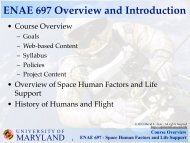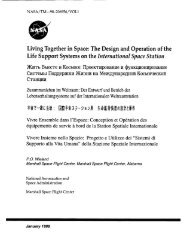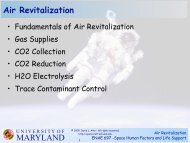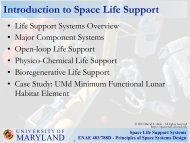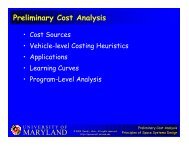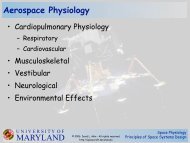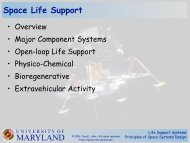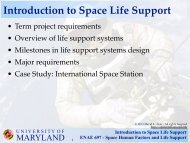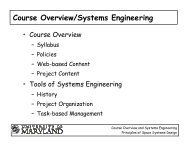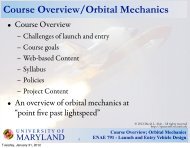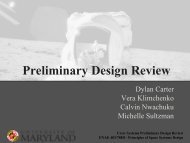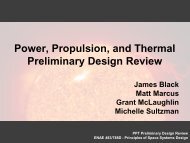Space Systems Laboratory - Dave Akin's Web Site
Space Systems Laboratory - Dave Akin's Web Site
Space Systems Laboratory - Dave Akin's Web Site
You also want an ePaper? Increase the reach of your titles
YUMPU automatically turns print PDFs into web optimized ePapers that Google loves.
Course Overview/Design Project<br />
• Lecture #01 – August 30, 2012<br />
• Course Overview<br />
– Goals<br />
– <strong>Web</strong>-based Content<br />
– Syllabus<br />
– Policies<br />
• 2012/13 Design Projects<br />
U N I V E R S I T Y O F<br />
MARYLAND<br />
1<br />
© 2012 David L. Akin - All rights reserved<br />
http://spacecraft.ssl.umd.edu<br />
Course Introduction/Team Projects<br />
ENAE 483/788D - Principles of <strong>Space</strong> <strong>Systems</strong> Design
Contact Information<br />
Dr. <strong>Dave</strong> Akin<br />
<strong>Space</strong> <strong>Systems</strong> <strong>Laboratory</strong><br />
Neutral Buoyancy Research Facility/Room 2100D<br />
301-405-1138<br />
dakin@ssl.umd.edu<br />
http://spacecraft.ssl.umd.edu<br />
U N I V E R S I T Y O F<br />
MARYLAND<br />
2<br />
Course Introduction/Team Projects<br />
ENAE 483/788D - Principles of <strong>Space</strong> <strong>Systems</strong> Design
Goals of ENAE 483/484 (and 788D)<br />
• Learn the basic tools and techniques of systems<br />
analysis and space vehicle design<br />
• Understand the open-ended and iterative nature of<br />
the design process<br />
• Simulate the cooperative group engineering<br />
environment of the aerospace profession<br />
• Develop experience and skill sets for working in<br />
teams<br />
• Perform and document professional-quality systems<br />
design of focused space mission concepts<br />
U N I V E R S I T Y O F<br />
MARYLAND<br />
3<br />
Course Introduction/Team Projects<br />
ENAE 483/788D - Principles of <strong>Space</strong> <strong>Systems</strong> Design
Outline of <strong>Space</strong> <strong>Systems</strong><br />
• ENAE 483/788D (Fall)<br />
– Lecture style, problem sets and quizzes<br />
– Design as a discipline<br />
– Disciplinary subjects not contained in curriculum<br />
– Engineering graphics<br />
• ENAE 484 (Spring)<br />
– Single group design project<br />
– Externally imposed matrix organization<br />
– Engineering presentations<br />
– Group dynamics<br />
– Peer evaluations<br />
U N I V E R S I T Y O F<br />
MARYLAND<br />
4<br />
Course Introduction/Team Projects<br />
ENAE 483/788D - Principles of <strong>Space</strong> <strong>Systems</strong> Design
But... (Recent Changes)<br />
• Emphasize project content<br />
– Start 484 project at beginning of 483<br />
– Build teams for spring term in the fall<br />
– Add specific lectures for project specialties<br />
– Provide opportunities for both experimentalists and<br />
theoreticians<br />
• “Design/Build/Test/Evaluate”<br />
– <strong>Space</strong> equivalent to “design/build/fly” for aero side<br />
– Parallels mission-level design activities<br />
– Major system(s) relevant to national programs<br />
U N I V E R S I T Y O F<br />
MARYLAND<br />
5<br />
Course Introduction/Team Projects<br />
ENAE 483/788D - Principles of <strong>Space</strong> <strong>Systems</strong> Design
<strong>Web</strong>-based Course Content<br />
• Data web site at http://spacecraft.ssl.umd.edu<br />
– Syllabus and course information<br />
– Lecture notes<br />
– Problems and solutions<br />
• Collaboration site and lecture videos at https://<br />
elms.umd.edu (Blackboard)<br />
• Akin’s Laws of <strong>Space</strong>craft Design at<br />
http://spacecraft.ssl.umd.edu/akins_laws.html<br />
U N I V E R S I T Y O F<br />
MARYLAND<br />
6<br />
Course Introduction/Team Projects<br />
ENAE 483/788D - Principles of <strong>Space</strong> <strong>Systems</strong> Design
Akin’s Laws of <strong>Space</strong>craft Design - #1<br />
Engineering is done with numbers.<br />
Analysis without numbers is only an<br />
opinion.<br />
U N I V E R S I T Y O F<br />
MARYLAND<br />
7<br />
Course Introduction/Team Projects<br />
ENAE 483/788D - Principles of <strong>Space</strong> <strong>Systems</strong> Design
Overview of the Design Process<br />
Program Objectives<br />
System Requirements<br />
Increasing complexity<br />
Increasing accuracy<br />
Vehicle-level Estimation<br />
(based on a few parameters<br />
from prior art)<br />
Decreasing ability<br />
to comprehend the “big<br />
picture”<br />
U N I V E R S I T Y O F<br />
MARYLAND<br />
8<br />
System-level Estimation<br />
(system parameters based on<br />
prior experience)<br />
Basic Axiom: Relative<br />
rankings between<br />
competing systems will<br />
remain consistent from<br />
level to level<br />
System-level Design<br />
(based on disciplineoriented<br />
analysis)<br />
Course Introduction/Team Projects<br />
ENAE 483/788D - Principles of <strong>Space</strong> <strong>Systems</strong> Design
Akin’s Laws of <strong>Space</strong>craft Design - #3<br />
Design is an iterative process. The<br />
necessary number of iterations is one more<br />
than the number you have currently done.<br />
This is true at any point in time.<br />
U N I V E R S I T Y O F<br />
MARYLAND<br />
9<br />
Course Introduction/Team Projects<br />
ENAE 483/788D - Principles of <strong>Space</strong> <strong>Systems</strong> Design
Syllabus Overview<br />
• Fundamentals of <strong>Space</strong>craft Design<br />
- Principles and tools of <strong>Systems</strong> Engineering<br />
- Vehicle-level design<br />
- <strong>Systems</strong>-level estimation<br />
• Component Detailed Design<br />
- Crew systems<br />
- Avionics<br />
- Power, Propulsion, and Thermal Analysis<br />
- Loads, Structures, and Mechanisms<br />
• Team Projects<br />
U N I V E R S I T Y O F<br />
MARYLAND<br />
10<br />
Course Introduction/Team Projects<br />
ENAE 483/788D - Principles of <strong>Space</strong> <strong>Systems</strong> Design
Syllabus 1: Fundamentals of <strong>Space</strong> <strong>Systems</strong><br />
• <strong>Systems</strong> Engineering<br />
• <strong>Space</strong> Environment<br />
• Orbital Mechanics<br />
• Engineering Graphics<br />
• Engineering Economics<br />
• Design Case Studies<br />
U N I V E R S I T Y O F<br />
MARYLAND<br />
11<br />
Course Introduction/Team Projects<br />
ENAE 483/788D - Principles of <strong>Space</strong> <strong>Systems</strong> Design
Syllabus 2: Vehicle/System-Level Design<br />
• Rocket Performance<br />
• Parametric Analysis<br />
• Cost Estimation<br />
• Reliability and Redundancy<br />
• Confidence, Risk, and Resiliency<br />
• Mass Estimating Relations<br />
• Resource Budgeting<br />
U N I V E R S I T Y O F<br />
MARYLAND<br />
12<br />
Course Introduction/Team Projects<br />
ENAE 483/788D - Principles of <strong>Space</strong> <strong>Systems</strong> Design
Problem Sets<br />
• Each of the <strong>Systems</strong> Design lectures (during the<br />
first third of the course) will have associated<br />
problem sets<br />
• These problem sets will form the knowledge basis<br />
for the midterm exam<br />
U N I V E R S I T Y O F<br />
MARYLAND<br />
13<br />
Course Introduction/Team Projects<br />
ENAE 483/788D - Principles of <strong>Space</strong> <strong>Systems</strong> Design
Syllabus 3: Component-Level Design<br />
• Loads, Structures, and Mechanisms<br />
– Loads Estimation<br />
– Structural Analysis<br />
– Structures and Mechanisms Design<br />
• Propulsion, Power, and Thermal<br />
– Propulsion System Design<br />
– Power System Design<br />
– Thermal Design and Analysis<br />
• Avionics <strong>Systems</strong><br />
– Attitude Dynamics/Proximity Operations<br />
– Data Management; GN&C<br />
– Communications<br />
U N I V E R S I T Y O F<br />
MARYLAND<br />
14<br />
Course Introduction/Team Projects<br />
ENAE 483/788D - Principles of <strong>Space</strong> <strong>Systems</strong> Design
Syllabus 4: Component-Level Design<br />
• Crew <strong>Systems</strong><br />
<strong>Space</strong> Physiology<br />
Human Factors and Habitability<br />
Life Support <strong>Systems</strong> Design<br />
• Other Topics<br />
Case studies (e.g., last year’s project)<br />
Special lectures for this year’s project(s)<br />
U N I V E R S I T Y O F<br />
MARYLAND<br />
15<br />
Course Introduction/Team Projects<br />
ENAE 483/788D - Principles of <strong>Space</strong> <strong>Systems</strong> Design
Team Design Exercises<br />
• Each of the four specialty areas will have an<br />
associated design project<br />
• This will be performed by teams of 4-5 students -<br />
I will assign people to each team<br />
• The results of the design exercise will be<br />
submitted as presentation slides (PowerPoint or<br />
equivalent)<br />
• Team grades will be assigned for each design<br />
exercise, including adherence to the principles of<br />
the engineering communications lecture<br />
U N I V E R S I T Y O F<br />
MARYLAND<br />
16<br />
Course Introduction/Team Projects<br />
ENAE 483/788D - Principles of <strong>Space</strong> <strong>Systems</strong> Design
Course Syllabus<br />
• Maintained on web site (follow links or<br />
http://spacecraft.ssl.umd.edu/academics/<br />
483F12/483F12.index.html)<br />
• Contains links to reference material, problem sets,<br />
solution sets, team project details, etc.<br />
• Notes and announcements will be posted at top of<br />
syllabus page as necessary<br />
• Every class has associated homework content;<br />
every homework has a full solution set posted after<br />
homework due date<br />
U N I V E R S I T Y O F<br />
MARYLAND<br />
17<br />
Course Introduction/Team Projects<br />
ENAE 483/788D - Principles of <strong>Space</strong> <strong>Systems</strong> Design
Fall 2012 Initial Syllabus (1)<br />
U N I V E R S I T Y O F<br />
MARYLAND<br />
18<br />
Course Introduction/Team Projects<br />
ENAE 483/788D - Principles of <strong>Space</strong> <strong>Systems</strong> Design
Fall 2012 Initial Syllabus (2)<br />
U N I V E R S I T Y O F<br />
MARYLAND<br />
19<br />
Course Introduction/Team Projects<br />
ENAE 483/788D - Principles of <strong>Space</strong> <strong>Systems</strong> Design
Grading Policies<br />
• Grade Distribution<br />
– 20% Homework Problems<br />
– 20% Midterm Exam<br />
– 30% Team Design Exercises*<br />
– 30% Final Exam<br />
• Late Policy<br />
– On time: Full credit<br />
– Before solutions: 70% credit<br />
– After solutions: 20% credit<br />
U N I V E R S I T Y O F<br />
MARYLAND<br />
20<br />
* Team Grades<br />
Course Introduction/Team Projects<br />
ENAE 483/788D - Principles of <strong>Space</strong> <strong>Systems</strong> Design
A Word on Homework Submissions...<br />
• Good methods of handing in homework<br />
– Hard copy in class (best!)<br />
– Scanned copies via e-mail (please put “ENAE483” or<br />
“ENAE788D” in subject line)<br />
• Methods that don’t work so well<br />
– Leaving it in my mailbox (particularly in EGR)<br />
– Leaving it in my office<br />
– Spreadsheets or .m files<br />
– Handing it to me in random locations<br />
– Handing it to Dr. Bowden<br />
U N I V E R S I T Y O F<br />
MARYLAND<br />
21<br />
Course Introduction/Team Projects<br />
ENAE 483/788D - Principles of <strong>Space</strong> <strong>Systems</strong> Design
A Word about Homework Grading<br />
• Homework is graded via a discrete filter<br />
– ✓ for homework problems which are essentially<br />
correct (10 pts)<br />
– ✓- for homework with significant problems (7 pts)<br />
– ✓-- for homework with major problems (4 pts)<br />
– ✓+ for homework demonstrating extra effort (12 pts)<br />
– 0 for missing homework<br />
• A detailed solution document is posted for each<br />
problem after the due date, which you should<br />
review to ensure you understand the techniques<br />
used<br />
U N I V E R S I T Y O F<br />
MARYLAND<br />
22<br />
Course Introduction/Team Projects<br />
ENAE 483/788D - Principles of <strong>Space</strong> <strong>Systems</strong> Design
Selection of Class Projects<br />
• Criteria - needs to be<br />
– a significant engineering challenge<br />
– of relevance to the current or future space program<br />
– requiring the use of tools from 483 and prior classes<br />
– and of appropriate scope for this class.<br />
• Preferable to be appropriate for entry into design<br />
competitions<br />
• My personal preference is to look at topical issues<br />
and pursue options not currently being considered<br />
in detail by NASA<br />
U N I V E R S I T Y O F<br />
MARYLAND<br />
23<br />
Course Introduction/Team Projects<br />
ENAE 483/788D - Principles of <strong>Space</strong> <strong>Systems</strong> Design
NASA’s <strong>Space</strong> Exploration Program<br />
• Developing Saturn V-class launch vehicle (“<strong>Space</strong><br />
Launch System” or SLS) and 4-person spacecraft<br />
(“Multi-Purpose Crewed Vehicle” or MPCV)<br />
• SLS will cost between $20B and $40B, starting at<br />
70 MT payload and evolving to 130 MT<br />
• No human flights until ~2020; start developing<br />
lunar landing vehicle then - first human lunar<br />
landing probably 2029-2030<br />
U N I V E R S I T Y O F<br />
MARYLAND<br />
24<br />
Course Introduction/Team Projects<br />
ENAE 483/788D - Principles of <strong>Space</strong> <strong>Systems</strong> Design
Logistics and Operations versus<br />
Heavy Lift: Examining Approaches to<br />
U N I V E R S I T Y O F<br />
MARYLAND<br />
Human Exploration in a<br />
Cost-Constrained Era<br />
David L. Akin<br />
AIAA Paper 2011-7221<br />
<strong>Space</strong> 2011 Conference<br />
<strong>Space</strong> <strong>Systems</strong> <strong>Laboratory</strong>
Amundsen-Scott South Pole Station<br />
U N I V E R S I T Y O F<br />
MARYLAND<br />
26<br />
<strong>Space</strong> <strong>Systems</strong> <strong>Laboratory</strong>
Logistics Support for Station Construction<br />
U N I V E R S I T Y O F<br />
MARYLAND<br />
27<br />
• 24,000,000 pounds of<br />
hardware and<br />
consumables<br />
• Flown in on 925 flights<br />
of existing LC-130<br />
cargo aircraft<br />
• Mean average<br />
temperature -47°C<br />
•
Parallels in Transport <strong>Systems</strong>?<br />
LC-130<br />
11,800 kg payload<br />
U N I V E R S I T Y O F<br />
MARYLAND<br />
28<br />
Delta IV Heavy<br />
23,000 kg payload to LEO<br />
9980 kg to LTO<br />
<strong>Space</strong> <strong>Systems</strong> <strong>Laboratory</strong>
Study Phase 1 Summary<br />
• AIAA Paper 2010-2293, <strong>Space</strong>Ops 2010<br />
• Assumptions:<br />
– Delta IV Heavy only<br />
– In-space use of storable hypergolics only<br />
– No propellant depots or transfers<br />
– Keep annual funding ≤ $3B<br />
• Focus of study effort<br />
– Feasibility of modular vehicle performance for lunar<br />
landing<br />
– Assessment of cost benefits of large production and<br />
flight rates<br />
U N I V E R S I T Y O F<br />
MARYLAND<br />
29<br />
<strong>Space</strong> <strong>Systems</strong> <strong>Laboratory</strong>
Notional Program Elements<br />
Crew Vehicle<br />
4990 kg<br />
U N I V E R S I T Y O F<br />
MARYLAND<br />
30<br />
Lunar Landing<br />
Module (LLM)<br />
6950 kg<br />
Orbital Propulsion<br />
Module (OPM)<br />
6950 kg<br />
<strong>Space</strong> <strong>Systems</strong> <strong>Laboratory</strong>
Single Launch Lunar Cargo Mission<br />
U N I V E R S I T Y O F<br />
MARYLAND<br />
Landed Cargo 1890 kg<br />
31<br />
<strong>Space</strong> <strong>Systems</strong> <strong>Laboratory</strong>
LLO Staging for Human Lunar Landing<br />
U N I V E R S I T Y O F<br />
MARYLAND<br />
32<br />
<strong>Space</strong> <strong>Systems</strong> <strong>Laboratory</strong>
Notional Vehicle in Landing Configuration<br />
U N I V E R S I T Y O F<br />
MARYLAND<br />
33<br />
<strong>Space</strong> <strong>Systems</strong> <strong>Laboratory</strong>
Comparison of Lunar Landing Vehicles<br />
U N I V E R S I T Y O F<br />
MARYLAND<br />
34<br />
<strong>Space</strong> <strong>Systems</strong> <strong>Laboratory</strong>
Results of Phase 1 Study<br />
• Use direct injection into Lunar transfer orbit and<br />
perform all in-space operations in low Lunar orbit<br />
(LLO)<br />
• Develop three vehicles based on LTO payload of<br />
DIVH and mutual performance<br />
– Orbital Maneuvering Stage (OMS)<br />
– Terminal Landing Stage (TLS)<br />
– Crew Module<br />
• Adapt standard modules to specific missions<br />
through multiple stages, offloading propellant<br />
U N I V E R S I T Y O F<br />
MARYLAND<br />
35<br />
<strong>Space</strong> <strong>Systems</strong> <strong>Laboratory</strong>
Year-by-Year Program Costs<br />
U N I V E R S I T Y O F<br />
MARYLAND<br />
36<br />
<strong>Space</strong> <strong>Systems</strong> <strong>Laboratory</strong>
Study Phase 2 Summary<br />
• AIAA Paper 2010-8610, <strong>Space</strong> 2010<br />
• Assumptions:<br />
– Mixed launch fleet (Delta IV Heavy and Atlas 402)<br />
– In-space use of storable hypergolics only<br />
– No propellant depots or transfers<br />
– Keep annual funding ≤ $3B<br />
• Focus of study effort<br />
– Probabilistic risk analysis of multilaunch missions<br />
– Cost incorporation of (limited) multiple launch vehicles<br />
U N I V E R S I T Y O F<br />
MARYLAND<br />
37<br />
<strong>Space</strong> <strong>Systems</strong> <strong>Laboratory</strong>
Monolythic vs. Modular Reliability<br />
U N I V E R S I T Y O F<br />
MARYLAND<br />
38<br />
<strong>Space</strong> <strong>Systems</strong> <strong>Laboratory</strong>
Design Reference Mission<br />
U N I V E R S I T Y O F<br />
MARYLAND<br />
39<br />
<strong>Space</strong> <strong>Systems</strong> <strong>Laboratory</strong>
Annual Program Expenditures<br />
85% Learning Curve used for all repetitive production<br />
U N I V E R S I T Y O F<br />
MARYLAND<br />
40<br />
<strong>Space</strong> <strong>Systems</strong> <strong>Laboratory</strong>
Focus of This Study (Phase 3)<br />
• Improve accuracy of vehicle design estimates<br />
– Incorporate mass dependence of stage inert mass<br />
fraction<br />
– Investigate sensitivity to specific impulse assumptions<br />
• Revisit lunar architecture with revised vehicle<br />
parameters<br />
• Extend architecture to near-Earth objects (NEOs)<br />
and Mars orbit destinations<br />
• Perform trade studies for phased introduction of<br />
additional technologies<br />
U N I V E R S I T Y O F<br />
MARYLAND<br />
41<br />
<strong>Space</strong> <strong>Systems</strong> <strong>Laboratory</strong>
Cost Sensitivity to Vehicle Size<br />
U N I V E R S I T Y O F<br />
MARYLAND<br />
42<br />
<strong>Space</strong> <strong>Systems</strong> <strong>Laboratory</strong>
Sensitivity to Specific Impulse<br />
U N I V E R S I T Y O F<br />
MARYLAND<br />
43<br />
<strong>Space</strong> <strong>Systems</strong> <strong>Laboratory</strong>
Comparison of New Module Parameters<br />
OPM<br />
LLM<br />
U N I V E R S I T Y O F<br />
MARYLAND<br />
44<br />
<strong>Space</strong> <strong>Systems</strong> <strong>Laboratory</strong>
Lunar Cargo Mission Performance<br />
U N I V E R S I T Y O F<br />
MARYLAND<br />
45<br />
<strong>Space</strong> <strong>Systems</strong> <strong>Laboratory</strong>
Human Lunar Landing Configuration<br />
U N I V E R S I T Y O F<br />
MARYLAND<br />
46<br />
<strong>Space</strong> <strong>Systems</strong> <strong>Laboratory</strong>
Implications of Parametric Resizing<br />
• Reduced OPM performance eliminates singlemodule<br />
lunar ascent option<br />
– Two OPMs landed for ascent with partial fueling in first<br />
stage<br />
– Both OPMs are single failure points for ascent<br />
• Since abort-to-orbit option exists throughout<br />
descent, no change in crew safety for that phase,<br />
but additional risk to mission success<br />
• Introduce option for larger vehicles → assume<br />
Falcon Heavy availability (16,000 kg to TLI)<br />
U N I V E R S I T Y O F<br />
MARYLAND<br />
47<br />
<strong>Space</strong> <strong>Systems</strong> <strong>Laboratory</strong>
OPM Parameters for FH Variant<br />
U N I V E R S I T Y O F<br />
MARYLAND<br />
48<br />
<strong>Space</strong> <strong>Systems</strong> <strong>Laboratory</strong>
Lunar Landing Configuration Options<br />
U N I V E R S I T Y O F<br />
MARYLAND<br />
49<br />
<strong>Space</strong> <strong>Systems</strong> <strong>Laboratory</strong>
Assessment of FH Module Options<br />
• Use of OPM-F for ascent propulsion provides<br />
maximum reliability<br />
• Either of the last two options (all OPM-F or all<br />
OMP-F/LLM-F) provide human lunar surface<br />
missions with six launches, and are acceptable for<br />
lunar exploration program<br />
U N I V E R S I T Y O F<br />
MARYLAND<br />
50<br />
<strong>Space</strong> <strong>Systems</strong> <strong>Laboratory</strong>
Future Work<br />
• Better graphics!<br />
• Detailed design of vehicles (crew module, propulsion<br />
modules)<br />
• Perform analysis for forward-staging modules in low<br />
Martian orbit for cargo and human Mars surface access<br />
• Perform reliability and costing analyses for NEO and<br />
Mars cases<br />
• Develop overall program design incorporating phased<br />
development of additional capabilities (Falcon Heavy<br />
modules, LEO staging modules, LOX/LH2 stages) into<br />
active mission model with budget caps<br />
• Consider additional advanced technologies (orbital<br />
depots, aerobraking, reusability) for future missions<br />
U N I V E R S I T Y O F<br />
MARYLAND<br />
51<br />
<strong>Space</strong> <strong>Systems</strong> <strong>Laboratory</strong>
Conclusions<br />
• Use of simple existing technologies still provides<br />
early, affordable, repeatable human access to the<br />
lunar surface<br />
• More conservative vehicle estimates support use<br />
of larger launch vehicles if available<br />
• Deep space missions should be staged in LEO<br />
• Long-duration LOX/LH2 stages facilitate NEO<br />
missions and are highly advantageous for Mars<br />
• An evolutionary program concept using on-orbit<br />
staging will provide a robust, ongoing human<br />
exploration program without waiting for the<br />
development of super-heavy lift vehicles<br />
U N I V E R S I T Y O F<br />
MARYLAND<br />
52<br />
<strong>Space</strong> <strong>Systems</strong> <strong>Laboratory</strong>
A Few Additional Notes<br />
• All of these papers are posted on the web site<br />
under Lecture #01<br />
• Fourth paper in the series in preparation for AIAA<br />
<strong>Space</strong> 2012 conference; preprint will be available<br />
next week<br />
• This material is presented only as point of<br />
departure (POD); it is to provide some initial<br />
guidance, not to be accepted as “gospel”<br />
• I expect the 42 of you to go into much greater<br />
depth of design analysis than I did on my own!<br />
U N I V E R S I T Y O F<br />
MARYLAND<br />
53<br />
Course Introduction/Team Projects<br />
ENAE 483/788D - Principles of <strong>Space</strong> <strong>Systems</strong> Design
Organization of the Design Project<br />
• You will be divided into three cooperating teams:<br />
– Human spacecraft design team<br />
– Transportation design team<br />
– Surface systems design team<br />
• There will also be a program-level systems<br />
integration and mission planning team<br />
• All of the design projects this term will be directly<br />
applicable to the capstone project for 484<br />
U N I V E R S I T Y O F<br />
MARYLAND<br />
54<br />
Course Introduction/Team Projects<br />
ENAE 483/788D - Principles of <strong>Space</strong> <strong>Systems</strong> Design
Design/Build/Test/Evaluate<br />
• Hardware design, fabrication, and testing will be an<br />
integral part of the 484 capstone project<br />
• A requirement for this term is to figure out what<br />
you’re building next term<br />
• Choice is based on<br />
– Getting design data unobtainable by analysis (e.g.,<br />
human factors evaluation of crew capsule interior)<br />
– Enabling meaningful mission simulations<br />
– Providing value for competitions<br />
• Leveraging facilities and infrastructure of SSL<br />
U N I V E R S I T Y O F<br />
MARYLAND<br />
55<br />
Course Introduction/Team Projects<br />
ENAE 483/788D - Principles of <strong>Space</strong> <strong>Systems</strong> Design
End Goal: RASC-AL Competition<br />
U N I V E R S I T Y O F<br />
MARYLAND<br />
56<br />
Course Introduction/Team Projects<br />
ENAE 483/788D - Principles of <strong>Space</strong> <strong>Systems</strong> Design
Matrix Organization<br />
• Each project team is divided into six specialty<br />
groups<br />
– <strong>Systems</strong> Integration (SI)<br />
– Mission Planning and Analysis (MPA)<br />
– Loads, Structures, and Mechanisms (LSM)<br />
– Power, Propulsion, and Thermal (PPT)<br />
– Crew <strong>Systems</strong> (CS)<br />
– Avionics and Software (AVS)<br />
• You will be assigned to a project and a specialty<br />
group - but you do get to express your preferences<br />
U N I V E R S I T Y O F<br />
MARYLAND<br />
57<br />
Course Introduction/Team Projects<br />
ENAE 483/788D - Principles of <strong>Space</strong> <strong>Systems</strong> Design
<strong>Systems</strong> Integration<br />
• Overall coordination of design activities<br />
• Creation and tracking of budgets, particularly mass<br />
and cost<br />
• Maintenance of canonical system configuration<br />
documents<br />
• Vehicle- and system-level trade studies<br />
• Cost estimation<br />
• Tracking of vehicle center of gravity and inertia<br />
matrix<br />
• Advanced technology (e.g., robotics, EVA)<br />
U N I V E R S I T Y O F<br />
MARYLAND<br />
58<br />
Course Introduction/Team Projects<br />
ENAE 483/788D - Principles of <strong>Space</strong> <strong>Systems</strong> Design
Mission Planning and Analysis<br />
• Creation and maintenance of design reference<br />
mission(s) (DRM)<br />
• Orbital mechanics and launch/entry trajectories<br />
• Determination of operational mission objectives<br />
• Concept of operations (CONOPS)<br />
• Programmatic planning (sequence of missions)<br />
• Science instrument/payload definition<br />
U N I V E R S I T Y O F<br />
MARYLAND<br />
59<br />
Course Introduction/Team Projects<br />
ENAE 483/788D - Principles of <strong>Space</strong> <strong>Systems</strong> Design
Loads, Structures, and Mechanisms<br />
• Identification and estimation of loads sources<br />
• Structural design and analysis<br />
– Selection of structural shapes and materials<br />
– Stress modeling<br />
– Deformation estimation<br />
– Design optimization<br />
• Design of mechanisms (docking/berthing ports,<br />
separation mechanisms, launch holddowns, engine<br />
gimbals))<br />
• Tracking of critical margins of safety<br />
U N I V E R S I T Y O F<br />
MARYLAND<br />
60<br />
Course Introduction/Team Projects<br />
ENAE 483/788D - Principles of <strong>Space</strong> <strong>Systems</strong> Design
Power, Propulsion, and Thermal<br />
• Electrical power generation<br />
• Energy storage<br />
• Power management and conditioning<br />
• Primary propulsion (orbital maneuvering)<br />
• Reaction control system (rotation/translation)<br />
• Design of propellant storage and feed systems<br />
• Thermal modeling and analysis<br />
• Thermal control systems<br />
• Power budgets<br />
U N I V E R S I T Y O F<br />
MARYLAND<br />
61<br />
Course Introduction/Team Projects<br />
ENAE 483/788D - Principles of <strong>Space</strong> <strong>Systems</strong> Design
Crew <strong>Systems</strong><br />
• Internal layout<br />
• Emergency egress systems<br />
• Lighting and acoustics<br />
• Window and viewing analysis<br />
• Life support systems<br />
– Air revitalization<br />
– Water collection and regeneration<br />
– Cabin thermal control<br />
– Waste management<br />
– Food and hygiene<br />
• EVA accommodations<br />
U N I V E R S I T Y O F<br />
MARYLAND<br />
62<br />
Course Introduction/Team Projects<br />
ENAE 483/788D - Principles of <strong>Space</strong> <strong>Systems</strong> Design
Avionics and Software<br />
• Data management (flight computers)<br />
• Networking<br />
• Sensors<br />
• Power distribution<br />
• Guidance system<br />
• Control systems, including attitude control<br />
• Communications<br />
• Robot control systems<br />
• Software<br />
• Data transmission budgets<br />
U N I V E R S I T Y O F<br />
MARYLAND<br />
63<br />
Course Introduction/Team Projects<br />
ENAE 483/788D - Principles of <strong>Space</strong> <strong>Systems</strong> Design
Akin’s Laws of <strong>Space</strong>craft Design - #16<br />
The previous people who did a similar<br />
analysis did not have a direct pipeline to the<br />
wisdom of the ages. There is therefore no<br />
reason to believe their analysis over yours.<br />
There is especially no reason to present<br />
their analysis as yours.<br />
U N I V E R S I T Y O F<br />
MARYLAND<br />
64<br />
Course Introduction/Team Projects<br />
ENAE 483/788D - Principles of <strong>Space</strong> <strong>Systems</strong> Design
Akin’s Laws of <strong>Space</strong>craft Design - #17<br />
The fact that an analysis appears in print<br />
has no relationship to the likelihood of its<br />
being correct.<br />
U N I V E R S I T Y O F<br />
MARYLAND<br />
65<br />
Course Introduction/Team Projects<br />
ENAE 483/788D - Principles of <strong>Space</strong> <strong>Systems</strong> Design
ENAE 788D Design Project – 2012<br />
• Grad students will form a team for the four design<br />
projects throughout the term<br />
• Grads will also perform systems analyses and<br />
mission design for the same lunar program for the<br />
484 capstone project<br />
• Grads will complete their project and give a final<br />
presentation on their results on the last day of the<br />
term<br />
U N I V E R S I T Y O F<br />
MARYLAND<br />
66<br />
Course Introduction/Team Projects<br />
ENAE 483/788D - Principles of <strong>Space</strong> <strong>Systems</strong> Design
Akin’s Laws of <strong>Space</strong>craft Design - #35<br />
(de Saint-Exupery's Law of Design) A<br />
designer knows that he has achieved<br />
perfection not when there is nothing<br />
left to add, but when there is nothing<br />
left to take away.<br />
U N I V E R S I T Y O F<br />
MARYLAND<br />
67<br />
Course Introduction/Team Projects<br />
ENAE 483/788D - Principles of <strong>Space</strong> <strong>Systems</strong> Design
Documentation<br />
• In a group of 42 people, there are 861 possible<br />
communication paths between two people<br />
• Results and decisions you make will inevitably<br />
affect everyone else in the team<br />
• The 484 final report should be a comprehensive<br />
documentation of everything all 42 of you did on<br />
the project over this academic year<br />
• Document! Use archival electronic media (forums<br />
and postings on Blackboard) rather than informal<br />
(chat rooms, texts, e-mails)<br />
• If I can’t see it, you don’t get credit for it<br />
U N I V E R S I T Y O F<br />
MARYLAND<br />
68<br />
Course Introduction/Team Projects<br />
ENAE 483/788D - Principles of <strong>Space</strong> <strong>Systems</strong> Design
Akin’s Laws of <strong>Space</strong>craft Design - #22<br />
When in doubt, document.<br />
(Documentation requirements will<br />
reach a maximum shortly after the<br />
termination of a program.)<br />
U N I V E R S I T Y O F<br />
MARYLAND<br />
69<br />
Course Introduction/Team Projects<br />
ENAE 483/788D - Principles of <strong>Space</strong> <strong>Systems</strong> Design
Closing Comments<br />
• Focus on numerical analysis and systems<br />
engineering → this is not “hardware-bashing”<br />
• Look for your own design solutions → this is also<br />
not “catalog shopping”<br />
• Approach everything rigorously with numbers →<br />
this is also also not “adjective engineering”<br />
• Manage scope and risk along with cost, mass, and<br />
other design parameters<br />
• Be innovative, while remaining real<br />
• What you get out of the process is directly<br />
proportional to what you put in<br />
U N I V E R S I T Y O F<br />
MARYLAND<br />
70<br />
Course Introduction/Team Projects<br />
ENAE 483/788D - Principles of <strong>Space</strong> <strong>Systems</strong> Design
Today’s Assignment<br />
• Download and read the POD papers from the<br />
spacecraft web site<br />
• Watch the clip on the design of the Apollo Lunar<br />
Module from the episode “Spider” from the miniseries<br />
“From the Earth to the Moon” (posted)<br />
• Do assignment posted on http://<br />
spacecraft.ssl.umd.edu under Lecture #01(due<br />
Thursday 9/6)<br />
U N I V E R S I T Y O F<br />
MARYLAND<br />
71<br />
Course Introduction/Team Projects<br />
ENAE 483/788D - Principles of <strong>Space</strong> <strong>Systems</strong> Design
Akin’s Laws of <strong>Space</strong>craft Design - #9<br />
Not having all the information you need is<br />
never a satisfactory excuse for not starting<br />
the analysis.<br />
U N I V E R S I T Y O F<br />
MARYLAND<br />
72<br />
Course Introduction/Team Projects<br />
ENAE 483/788D - Principles of <strong>Space</strong> <strong>Systems</strong> Design



